B2B SEO Guide
Building a B2B SEO strategy that delivers results
Book a FREE SEO Strategy Consultation >
Further Reading:
A solid B2B SEO strategy is vital for driving organic traffic to your website.
As you know, high organic visibility throughout the sales funnel is a tried-and-tested method for accelerating business growth. But SEO for B2B companies presents unique challenges that require a different strategy from B2C SEO.
In this article, we’ll explain the main differences between B2C and B2B SEO and why these differences matter. We’ll then show you how to build a top B2B SEO strategy that delivers measurable results for your business.
What is B2B SEO?
Essentially, business-to-business SEO (B2B SEO) is search engine marketing for B2B companies.
The aim of B2B SEO is to increase organic traffic to your website by boosting your search engine rankings. This gets your website in front of more businesses that could benefit from your products or services, increasing your chances of a sale.
Like B2C SEO, there are three main pillars of B2B SEO:
- Technical SEO. Optimizing the technical aspects of your website, such as speed, responsiveness, and crawlability.
- Onsite SEO. Optimizing your website’s content, including metadata, content structure, and internal linking.
- Offsite SEO. Optimizations to increase exposure, like social media, reviews, and link building.
The challenge of B2B SEO is you’re targeting people buying for a business rather than themselves一which brings us to our next point.
What is the difference between B2B SEO & B2C SEO?
While there are no specific ranking factors for B2B SEO, in practice it’s very different from B2C SEO. The biggest differences are your audience and sales funnel.
B2B companies target a much smaller audience. Instead of a broad demographic, you’re targeting company decision-makers like CEOs and marketing managers. These decision-makers have very different buying behaviors from consumers.
B2B buyers spend a long time in the research stage of the sales funnel gathering information about the different options on offer. They also spend time consulting other stakeholders and negotiating the contract.
As a result, B2B sales funnels are usually more complex than B2C sales funnels, as the image below shows:
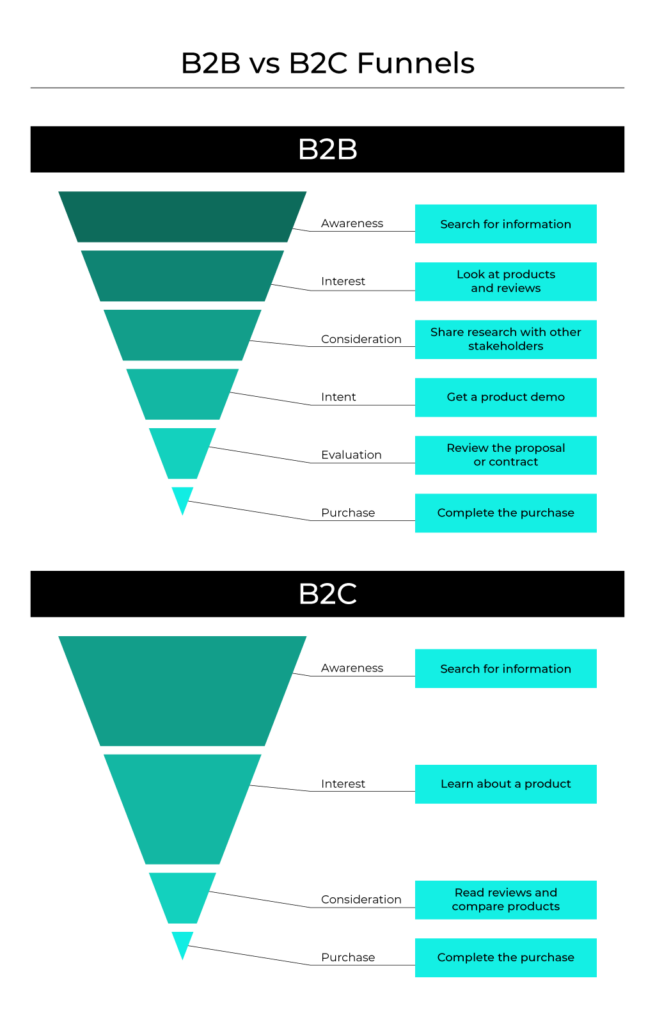
This translate into differences that impact your SEO strategy, namely:
- Keyword volume
- Conversion rate
- Content type
Keyword volume
More complex sales funnels mean more potential search terms. B2B keywords also tend to be specific and long-tail. Taken together, this means B2B keywords have a lower search volume than B2C keywords.
This may sound negative, but the people using these keywords are the ones who’ll be the most interested in your product or service. So, in B2B SEO, it’s actually beneficial to focus on low-volume keywords.
Conversion rate
Another difference is that B2B companies usually have lower conversion rates. The sales that do close, though, are more valuable than B2C sales.
The goal of SEO for B2B marketing is to attract high-value customers with valuable content that puts your company firmly in their minds. That way, when they’re ready to make a purchase, they’re more likely to come to you.
Content type
Since B2B SEO marketing has lower conversion rates, it’s vital to establish yourself as a useful source of information. This makes thought leadership content an essential part of B2B SEO; even more so than in B2C SEO.
You can incorporate thought leadership into your SEO strategy with blogging, guest posts, original research, webinars, and other high-quality content.
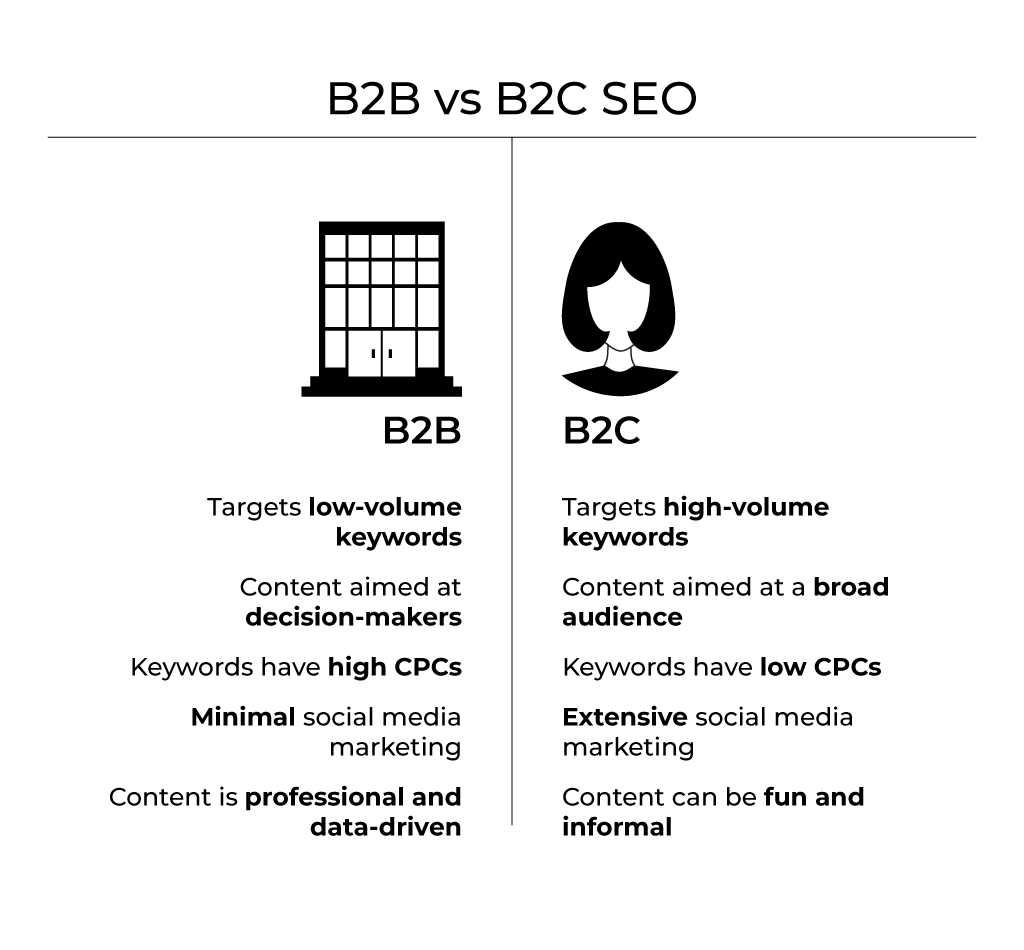
Creating an effective B2B SEO strategy
Now let’s focus on how to create a winning SEO strategy for B2B marketing. You can create a strategy yourself using the steps outlined below. Or, you can work with a professional B2B SEO agency, which will create an effective strategy for you.
For example, accelerate agency takes a 360-degree approach to SEO that combines technical, onsite, and offsite SEO. Our process includes a technical SEO audit, keyword gap analysis, onsite optimization, content creation, link building, and more, to help you meet一and exceed一your SEO goals.
If you prefer to keep your strategy in-house, there are five main steps you should take:
- Create a B2B buyer persona
- Conduct keyword research
- Optimize your website
- Create valuable B2B content
- Earn backlinks by promoting your content
Let’s go through them in detail.
1. Create a B2B buyer persona
You may be familiar with creating buyer personas for your marketing campaigns. B2B companies, though, target businesses, so you first need to figure out who in that business you need to reach.
Depending on the company, this could be a CEO, a product manager, or a CFO. You may also find you have more than one potential buyer. In this case, you’ll need several buyer personas.
Once you know who you’re targeting, think about what you need to know. Ask questions like:
- Which industry are they in?
- What is their job title?
- What are their responsibilities?
- What are their biggest challenges?
- What are their goals and objectives?
- How is their job measured?
- How do they make decisions?
- How big is their team?
- What do they need to do their job?
Pro Tip: You can use a tool like HubSpot’s Make My Persona to quickly create as many B2B buyer personas as you need. Just go to the website, click “Build My Persona”, and follow the onscreen steps.

2. Conduct keyword research
Next, you need to conduct keyword research based on your buyer personas. A good starting point is to ask yourself:
- What are the main challenges my personas face?
- How will they search for a solution to their pain points?
- What are the main features of my product or service?
Below are some of the ways you can find and organize the keywords your different buyer personas use.
Find keywords for each stage of your sales funnel
To maximize your SEO efforts, you need to create content for each stage of the sales funnel. That means finding the keywords your personas use in the top, middle, and bottom of the funnel.
1. Top of the funnel (TOFU) keywords
People at the top of the funnel are in the early stages of the buying journey, so they’re searching for information. TOFU content isn’t about converting them, but helping them find the answers they’re looking for.
TOFU keywords revolve around issues and opportunities. They include terms like “fix”, “problem”, “how to”, “reduce”, and “optimize”. So, look at each pain point in your buyer personas, think about your solution, and try to add one or more of those terms.
For example, let’s say you’re a company that supplies CRM software. Your potential customers’ pain points could include:
- Too much time spent in meetings
- An unstructured sales process
- Too long spent on administrative tasks
Your keywords could be things like “reduce meeting times”, “optimize the sales process”, and “how to save time in sales”.
Pro Tip: If you put these variations into a tool like Ubersuggest, it will give you dozens of related keywords to use for new blog topics.
2. Middle of the funnel (MOFU) keywords
People in the middle of the funnel are partway through the buying process. They’re starting to look for solutions, so they’re usually comparing alternatives.
If TOFU content is about attracting interest, MOFU content is about keeping it. Keywords here are all about solutions. So, you’ll need to use terms like “solution”, “provider”, “comparison”, “features”, and “software”. For instance, “CRM software features” or “comparison of CRM providers”.
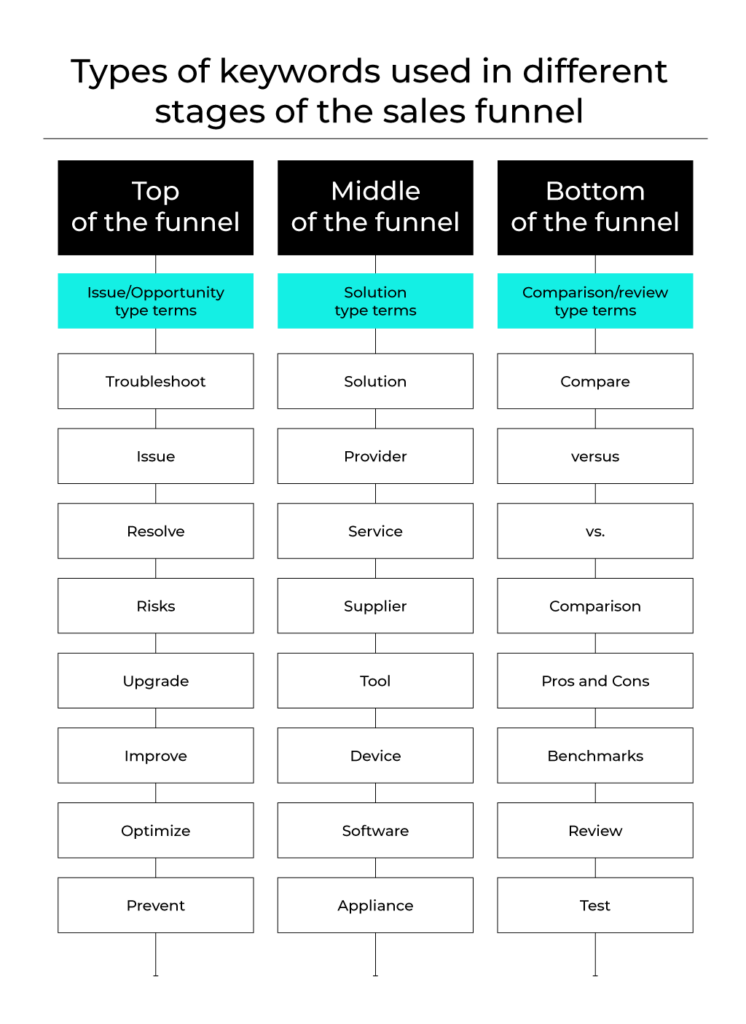
3. Bottom of the funnel (BOFU) keywords
By the time buyers reach the bottom of the funnel, they’re ready to make a decision. BOFU content is about showing people the benefits of your solution and why they should choose you over your competitors. In other words, it’s about converting.
BOFU keywords are about reviewing and testing, which means using terms like “pros and cons”, “reviews”, “pricing”, and “ratings”. For example, “[company A] pros and cons”, “[company A] vs [company B]”, and “[company A] reviews”.
Use keyword gap analysis to learn from your competitors
Another way to find relevant keywords is to analyze your competitors. For instance, keyword gap analysis lets you compare your keyword ranking to your competitors to find gaps in your strategy.
Use a tool like SEMrush or Ubersuggest to find keywords your competitors are ranking for that you aren’t. You can then create content around those keywords to see if you can outrank them.
Also, see if there are any long-tail keywords they’re not ranking for that you can exploit.
Pro Tip: Don’t just look at your direct competitors. Some websites may not sell the same solutions as you but rank well for the keywords you want to target. So, try to research a range of competing websites.
Group keywords by topic cluster
Once you’ve found relevant keywords, it’s helpful to group them into topic clusters. If you’re not familiar with the term, a topic cluster is a group of pages that revolve around a central topic. They use a pillar page to link to and from them, helping to boost your website’s SEO value.
Topic clusters help you target people at each stage of the sales funnel. They’re also great for organizing content and avoiding keyword cannibalization (when you optimize more than one page for the same keyword).
3. Optimize your website
Once you know which keywords your B2B buyers are searching for, you can optimize your website. Below are our tips on how to do that:
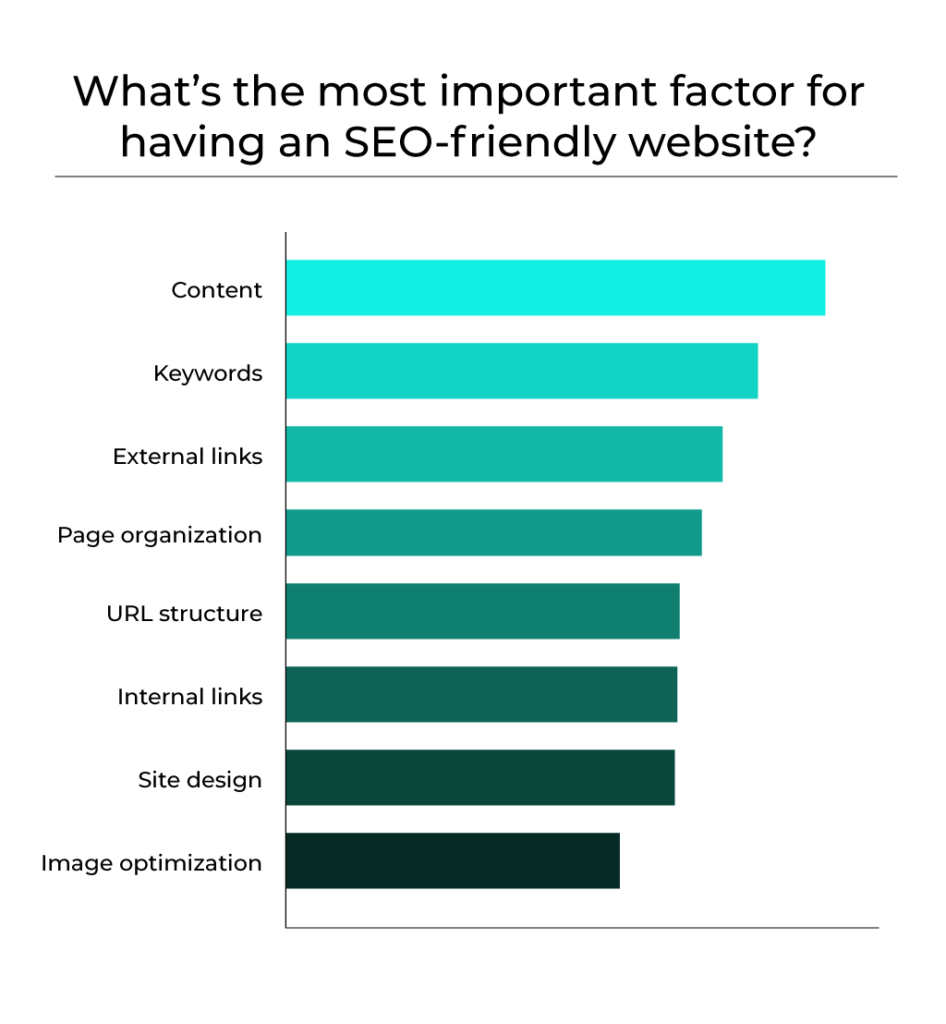
Perform a technical SEO audit
First, you should perform a technical SEO audit. This will assess how well your website is currently optimized for search engines.
It can highlight crawlability or indexing issues that are hindering your performance, plus technical problems like hreflang errors.
Based on the results of your audit, there could be minor changes you could make that would immediately improve your ranking. Or, your website may need a thorough optimization. In this case, it’s worth working with a SaaS SEO agency like accelerate agency.
accelerate agency can perform a technical SEO audit and optimize your website for you. We can also create high-quality content for your website, secure guest posting opportunities to build backlinks, and more.
Use your keywords wisely
For each page on your website, you should use your target keyword several times. Try to use it in the following places:
- URL
- Title tag
- Meta description
- H1 title
- The first sentence or paragraph of your copy
That said, it’s important to avoid keyword stuffing. Google defines keyword stuffing as:
“The practice of filling a web page with keywords or numbers in an attempt to manipulate rankings in Google Search results. Often these keywords appear in a list or group, unnaturally, or out of context.”
Keyword stuffing is a violation of Google’s spam policies. The penalty is a lower ranking or一worst case scenario一not ranking at all.
You can use keywords; you just have to use them wisely. That means including keywords naturally without sacrificing the reader experience. Use synonyms of your primary keyword, and don’t try to shoehorn it into every paragraph. You’ll probably find as you write your copy that it crops up naturally anyway.
Create original, evergreen content
Today, Google’s ranking factors focus more on content quality than quantity. Google rewards websites that give value to their readers, and the best way to do that is by offering original, evergreen content.
Your content must be original, or Google will penalize you for duplicate content. Unique content is also more likely to engage your potential buyers.
Evergreen content, meanwhile, stays relevant for longer and only needs minor updates once a year or so.
That’s not to say you shouldn’t create topical content. But evergreen content means less work in the long run, letting you focus on other areas of your B2B SEO strategy.
Optimize your site’s metadata
Metadata comprises your site’s title tags and meta descriptions. Your title tag is one of Google’s ranking factors, and it’s what Google displays in search results.
According to a study by Backlinko, the optimal title tag length is between 40 and 60 characters. Try not to go over 60 characters, or you’ll exceed Google’s title tag limit of 580 pixels. Also, include your primary keyword at the beginning of the title.
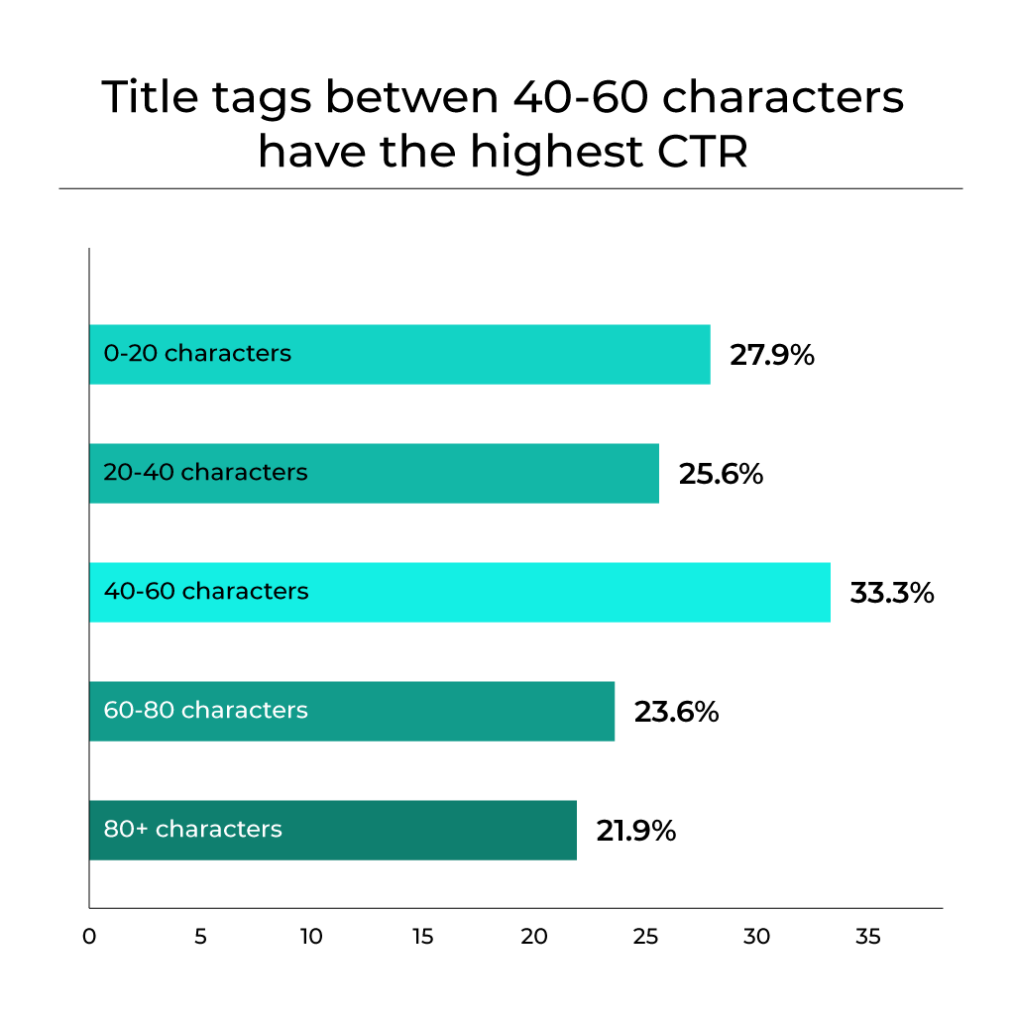
A meta description tells searchers what your page is about. It should include your primary keyword, and it needs to be engaging enough to encourage people to visit your page. If you don’t write one, then Google will choose a snippet to display, and that rarely encourages clicks.
Meta descriptions have a limit of 990 pixels or around 120 characters. To check you’re within the limit, you can use a tool like the Google SERP Snippet Optimization Tool.
Improve page loading speeds
If your site takes a long time to load, your potential customers will likely give up and try somewhere else. So, one of the best things you can do in B2B SEO is improve page loading speeds. Ideally, your pages should load in three seconds or less.
Some of the easiest ways to improve page speeds are to:
- Optimize code. Remove unnecessary characters, spaces, commas, and so on.
- Enable compression. Some users may not have the bandwidth to load your site. By enabling compression, your site will automatically reduce file sizes to load faster.
- Use smaller images. Large images are of higher quality but take longer to load. Reducing image sizes—even a little—can shave precious milliseconds off your load time.
Pro Tip: There are many online tools that can assess your website and suggest ways to improve page speed. An example is Google PageSpeed Insights.
Optimize your site for mobile
In 2020, Google switched to mobile-first indexing. This means your website’s indexing and ranking are mainly based on the mobile version of your site. To rank well, you need to optimize your site for mobile users.
The easiest way to test if your site is mobile-friendly is to open it on your mobile. If your text runs off the page or your site is hard to navigate, you know you need to make changes. You can also check your site with Google’s Mobile-Friendly Test.
To make your site mobile-friendly, use a responsive design that adapts automatically to any screen size.
4. Create valuable B2B content
After you’ve optimized your website, it’s time to get creative. Top B2B SEO strategies involve a variety of content formats to interest potential buyers, such as:
- Blog posts
- Research reports
- White papers
- eBooks
- Videos
- Templates and checklists
- Podcasts
- Social media posts
- Case studies
- Email newsletters
- Free and paid tools
- How-to guides
- Webinars
Below are our tips on how to create B2B content to rank well on SERPs and move more potential buyers through your sales funnel:
Create content that benefits your readers
Above all, the content you create should benefit your readers.
Most B2B buyers use search engines to find information, solutions, or perspectives. If you create content that fulfills those needs, you’ll gain a reputation as a useful source of information. Search engines will also reward you with a higher ranking.
Update and repurpose old content
Creating new content is important, but that doesn’t mean you should neglect your old content. Updating and repurposing content keeps it relevant and ensures all your content is working to improve your rankings.
Updating old content with the latest statistics and images is an easy way to give your content a refresh.
Repurposing goes a step further and completely changes the format and purpose of a piece. For instance, you could combine four 500-word pieces into one 2,000-word post (which also has greater value, as you’ll see next). Or, you could turn a blog post into a whitepaper or eBook.
Repurposing content takes a little longer, but it’s faster than creating new content from scratch.
Write long-form content
Long-form content is an important part of B2B SEO. It’s usually classed as any piece of content that exceeds 2,000 words (like this article, in fact). It includes posts, tutorials, case studies, and even videos or podcasts.
On average, long-form content attracts more backlinks than short-form content. Backlinks are important for building your domain’s authority. After all, if lots of websites are linking to you, you must have something worth reading.
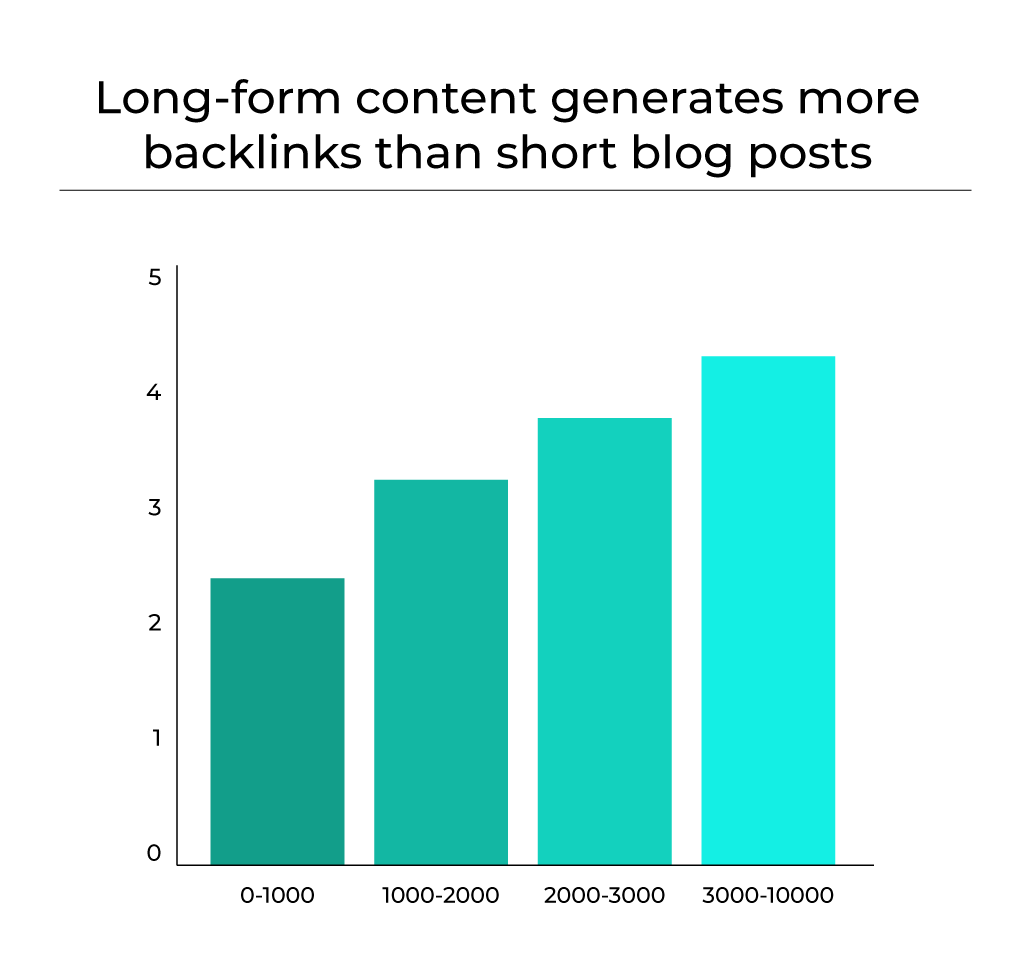
Plus, long-form content lets you explore a subject in more depth, which makes it more valuable. This builds your credibility and brings more visitors to your site一including your target personas.
Long-form content may take longer to produce, but the results are well worth the effort.
5. Earn backlinks by promoting your content
The final step in your B2B SEO strategy is to promote your content. Your aim here is to earn backlinks from high-quality websites. The more backlinks you have, the higher your ranking should be.
Here are some steps you can take to promote your content and secure backlinks:
Build a digital PR strategy
Digital PR involves creating sought-after content like original research and pitching it to industry publications.
A successful digital PR strategy involves the following activities:
- Networking with online reporters, journalists, and influencers
- Publishing high-quality content to build your reputation and secure backlinks from authoritative websites
- Optimizing press releases with ad campaigns and links to your website and blog
- Securing honest customer reviews
- Measuring the success of your strategy by tracking relevant KPIs
The publications you pitch to should be relevant to your target audience. So, look at your buyer personas and think about the kind of publications that will interest them.
Create a B2B partner program
Another strategy is to leverage your B2B partners. This could be as simple as asking your existing suppliers and other partners to link to your website. Or, you could go a step further and create a B2B partner program.
B2B partner marketing involves paying a partner company a commission or percentage each time they bring in a sale. You can also offer incentives like linking to each other’s websites, hosting co-webinars, and other activities to expand the reach of both businesses.
According to a recent survey, 83% of B2B companies found partner marketing an effective way to sell their products.
The most common benefits of partner programs are:
- More sales. Your partners can be an extension of your marketing team, increasing sales without hiring more staff.
- New audiences. Your partners can give you access to new audiences and markets, expanding your reach.
- Limited upfront investment. Done well, you’ll only pay for results, reducing risk and limiting your upfront investment.
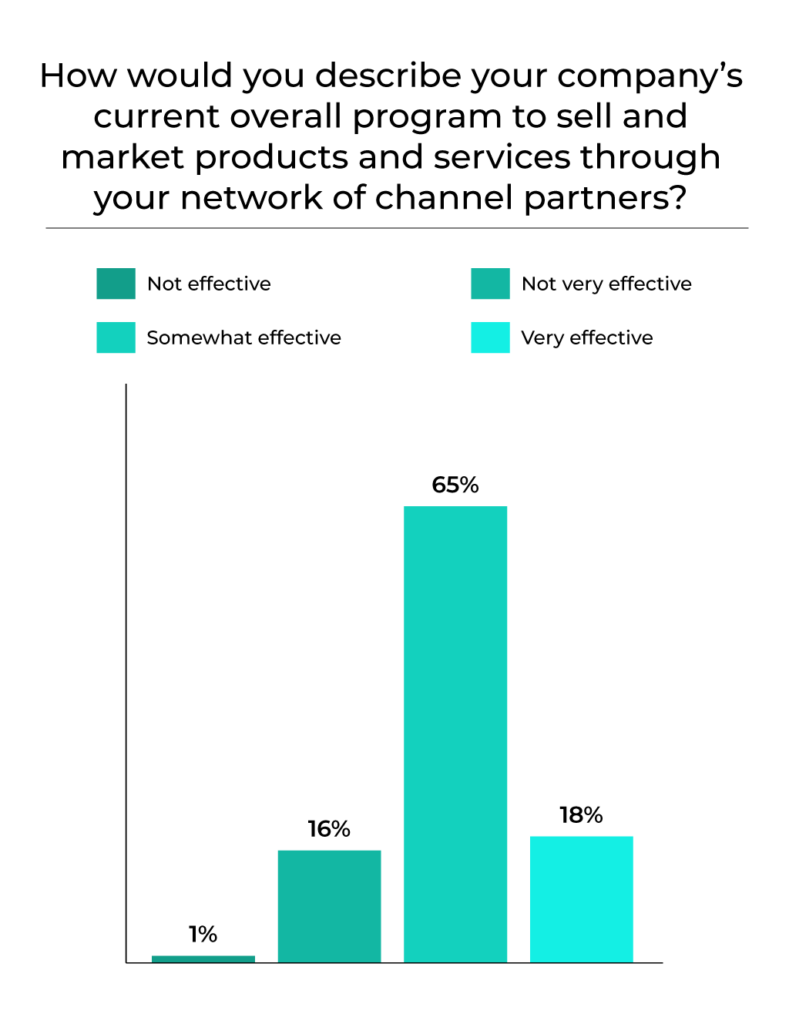
As you can see, a B2B partner program is an effective way to promote your business without breaking the bank.
Monitor your strategy to make improvements
Finally, as with all marketing campaigns, you need to track and analyze your B2B SEO strategy to see what’s working and what’s not. Then, you can make improvements.
For instance, if you’ve been stuck in the same keyword position for a few weeks, it could suggest a problem with your content. You can then dig deeper into the cause.
For example, you could send out a survey to ask customers what kind of content they’d like to see. Your analytics may also show that some of your content is performing better than the rest. If that’s the case, you can focus on creating more of it一and measuring the results.
Pro Tip: A tool like Google Search Console is great for tracking your website ranking, conversions, traffic, and more. Plus, it can highlight issues like broken or lost links, helping you optimize your website.
Inspiring B2B SEO success stories
If you want to avoid some of the trial and error of B2B SEO, one thing you can do is to look at the strategies of high-ranking websites.
Below are two examples of B2B companies that have used SEO to great effect:
Canva
There’s a good chance you or your team have designed something with Canva before. And it’s not surprising. According to Similar Web, Canva consistently has over 300 million site visitors per month.
Their secret? First of all, they rank first for terms like “color wheel”, “graph maker”, and “YouTube banner template”.
How?
By offering a solution to their audience’s pain point. For instance, someone searching for “YouTube banner template” probably wants to make one, and Canva can help them do that一for free!
Canva also has a ton of referring websites, which tells Google they have something worth showing people.

TravelPerk
TravelPerk is a business travel management solution. According to Similar Web, they generate over 40% of their traffic from SEO. At time of writing, they can boast almost 700,000 monthly site visits and 28 referring websites, and they’re continuing to grow organically.
How do they do it? Topic clusters are a big part of it.
TravelPerk uses topic clusters to create content for their entire sales funnel. For example, one of their topics is “flexible travel”. This topic forms the pillar page for four sub-topics:
- Flexible flights
- Flexible hotel booking
- Non-refundable flight tickets
- Non-refundable hotels
Each sub-topic links back to the pillar page, and also has links to other pages on the site. This creates a network of internal links一and Google loves internal linking!
Plus, by creating informative guides, TravelPerk has established itself as a useful source of information. And, as we’ve said, this is a great way to get site traffic.
Accelerate your growth with a B2B SEO strategy that delivers results
SEO for B2B companies is very different from B2C SEO. B2B SEO presents unique challenges like low keyword volumes, low conversion rates, and a smaller audience. So, to implement SEO successfully in B2B marketing, you need a different strategy.
In this article, we showed you a five-step process for building a B2B SEO strategy that delivers results. We’ve based many of our tips on our own process, which has delivered results for companies like Dialpad, Databricks, and Brightpearl.
Our holistic approach to SEO combines data and machine learning with human expertise to deliver measurable results that scale your business. Book a consultation and see how we could accelerate your business growth.